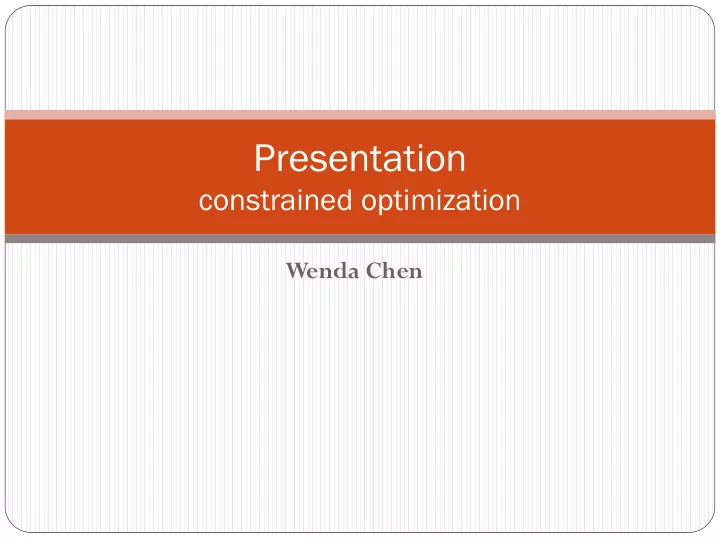

Presentation constrained optimization Wenda Chen
Speech Data and Constrained Optimization Models Part 1: Speech Signal data (continuous): Adaptive filtering and LMS ICA with Negentropy criteria for source separation Part 2: Transcription data (discrete) ( Present next time ): Dynamic programming for confusion network Linear regression and MMSE for feature analysis
Constrained Optimization Suppose we have a cost function (or objective function) Our aim is to find values of the parameters (decision variables) x that minimize this function Subject to the following constraints: equality: nonequality: If we seek a maximum of f ( x ) (profit function) it is equivalent to seeking a minimum of – f ( x )
Blind Source Separation Input: Source Signals Output: Estimated Source Components Signals received and collected are convolutive mixtures Pre-whitening:
Adaptive Filter to Independent Component Analysis (ICA) Work on the signals multiplication in frequency domain and in discrete frequency bands by taking short time FFT Adaptive filter framework with LMS method Negentropy maximization criteria from information theory, instead of target signal difference [2] In practice, due to the robustness to outliers, the cost function can be chosen as
Newton method Fit a quadratic approximation to f ( x ) using both gradient and curvature information at x . Expand f ( x ) locally using a Taylor series. Find the δx which minimizes this local quadratic approximation. Update x.
Newton method avoids the need to bracket the root quadratic convergence (decimal accuracy doubles at every iteration)
Newton method Global convergence of Newton’s method is poor. Often fails if the starting point is too far from the minimum. in practice, must be used with a globalization strategy which reduces the step length until function decrease is assured
Extension to N (multivariate) dimensions How big N can be? problem sizes can vary from a handful of parameters to many thousands
Taylor expansion A function may be approximated locally by its Taylor series expansion about a point x * where the gradient is the vector and the Hessian H ( x *) is the symmetric matrix
Equality constraints Minimize f ( x ) subject to: for The gradient of f ( x ) at a local minimizer is equal to the linear combination of the gradients of a i ( x ) with Lagrange multipliers as the coefficients. In the BSS problem,
Inequality constraints Minimize f ( x ) subject to: for The gradient of f ( x ) at a local minimizer is equal to the linear combination of the gradients of c j ( x ) , which are active ( c j ( x ) = 0 ) and Lagrange multipliers must be positive, In the BSS problem, and
Lagrangien We can introduce the function (Lagrangien) The necessary condition for the local minimizer is and it must be a feasible point (i.e. constraints are satisfied). These are Karush-Kuhn-Tucker conditions
Algorithm and Analysis For adaptive filtering, it is a MIMO optimization problem ICA with reference Reference signals are chosen when very limited information is available about the source signals E.g. Use autocorrelation signal as reference for speech Optimization cost function (Lagrange function) for frequency domain ICA with reference: Update weight and parameter using Newton’s method:
Results and Reconstruction of Time- domain Signals Collection of data: BSS SP package and complex valued speech data Hermitian symmetric signal property for inverse Fourier Transform Reconstruction of the speech signals in time domain with selected frequency bands and overlap add method Speed of the approaches: time domain method converges faster Source Mixtures Output Synthetic data SNR:
Recommend
More recommend